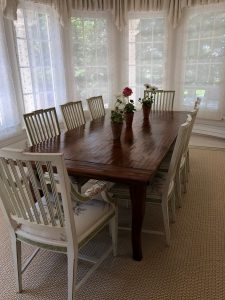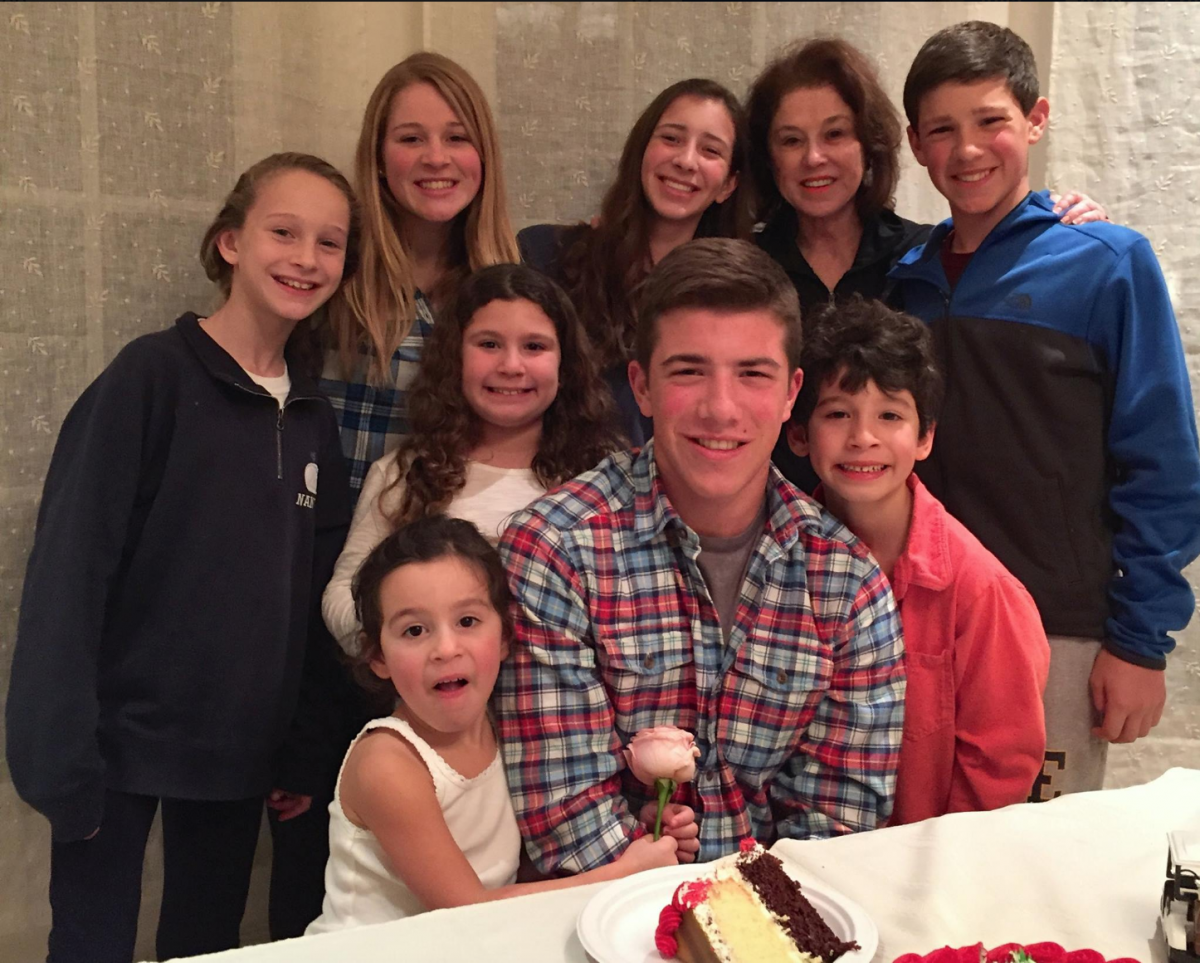My name is Julia Rogers and I am conducting a study in order to further understand the importance of a kitchen table that I eat at weekly. I believe that each table tells its own story through its size, shape, and most importantly, marks and bruises. To understand the dents on a table is understanding more than just an inanimate object but an entire group of people; a family. The table I observed is not out of the ordinary, in fact, this oversized wooden table belongs to Phyllis and Paul better known as my grandma and grandpa. I am one of nine grandchildren on my mother’s side. Nine grandchildren in addition to my two parents, four aunts and uncles, great aunt and uncle, second cousin and my beloved grandparents. My grandmother describes the task of squeezing all twenty of us around one table as “a complex one that has now become routine to us”. My family has used the table for over twenty years yet I never truly noticed the object. I was oblivious to the elegantly detailed cushions on each chair and the deeply engrained mahogany wood. I was so unaware that I was unable to recall whether the table contained a table cloth before traveling to my grandparents to check my unreliable memory. Now that my grandparents are moving to a new home, a new kitchen filled with a foreign table, I have used this reflection as an opportunity to observe their kitchen table. As I embark on this reflection, I am curious as to what meaning I will uncover behind the piece of furniture that has held the weight of my growing family for over twenty years before it is engraved in the memories of another.
In order to conduct this study, I used the anthropological method of participant-observation fused with interviews. While I am clearly aware of my own family story, I decided to observe before interviewing in order to allow myself to take an outsider’s perspective of the furniture and people before directly asking my grandmother about her table. According to the book, “Eating Culture” by Gillian Crowther, a crucial part of participant observation is partaking in the actual tasks, therefore, I did not observe from the sidelines rather, I remained a part of the dinner while recording observations. Following my intense observation, I decided to interview my grandmother, Phyllis, concerning some of the aspects of the table. The purpose of the interview was to reach a broader understanding of the table; one from those who use the space every day. From this, I was able to fact check my interpretations of the story and combine the two to create a deeper understanding of the table.
As I arrived at my grandparent’s hidden house, the story immediately began to unfold. This story is of a large rectangular table, eight seats on each side with one on each end. Twenty chairs crowded around the table insinuates a social family. My grandmother described her table as “The Goldilocks table, not too small not too big but just right for our family.” Now imagine this elongated rectangular table, a grainy mahogany finish coated with gloss, miniature dents engraining themselves around the outskirts. White, armless chairs crowd around elegantly filling the gaps surrounding the rectangle. Their once white cushions, with delicate floral accents, are splattered with stains, which suggests stories of past family gatherings. A splash of what appears to be a red sauce, a smudge of chocolate, a sprinkle of cake crumbs. Each chair contains its own story; its own pattern of spills. Strong smells of chicken and lightly salted potatoes waft through the kitchen and into the living room where the family gathers before the meal. Phyllis shoos stragglers out of the kitchen leaving the table vacant as it awaits the arrival of hungry guests. Everyone scurries to the living room where Paul, comfortably reclined in his chair, recites his famous stories. Family members gather around, gaping in awe at his astounding tales until, Phyllis shuffles into the living room, interrupting her husband in order to summon everyone back into the kitchen. “Supper’s ready, everyone grab a plate!” she echoes into the crowded room. The food flows across the island of the kitchen in a buffet manner. Garden salad with freshly made balsamic dressing, lightly salted finger potatoes, a neon yellow Jell-O with a creamy base, and finally an enormous roasted chicken, golden and crisp. Each family member chooses a plate from the pristinely set table and serves themselves family style, overflowing their plates with delicious food carefully prepared by Phyllis. Adults tend to drift towards the back of the line, allowing the children to eat first. There is no assigned seating although based on the way the family seats themselves it seems as if there is an invisible name card carefully placed at each chair. It appears to be a game of strategic musical chairs; the adults drifting towards one end with the children on the other. The last to sit, Phyllis and Paul, place themselves on each end of the large table. Phyllis sits on the kids end while Paul places himself at the head of the adults as they prepare themselves for more of his tales. The youngest cousin takes a small bite of her chicken and proceeds to slyly feed the rest to the dog, dropping juice onto the once clean seat cushions. Conversations loosely flow across the table of college, significant others, and sports teams. About forty-five minutes later, guests clear their plates carefully placing them into the dishwasher before returning to the now sloppy table. The adults remain circled around Paul while the children run to the living room to play games, and glare at the television. After dinner, for a moment, the once playful table becomes cramped with adult banter. Once everyone has made room in their expanding stomachs, Phyllis gathers the dessert. This, it seems, is her favorite part of the meal as she giddily places a birthday cake on the table which reads “Happy Birthday Samantha & Nicole!” She secretly swipes her finger across the frosting on the bottom to “take a taste to make sure it’s ok for everyone else to eat.” Upon interviewing Phyllis she explains that there are birthdays celebrated at almost every Sunday family dinner given the immense size of the family. This Sunday the family celebrates two sisters, Samantha and Nicole, as they reach a new year in their lives. Phyllis shuffles into the living room, summoning the children to crowd once more around the large rectangular table. They sing an enthusiastic happy birthday before gorging themselves in cake and ice cream. Laughter, stories, and three flavors of ice cream are passed around the table from one family member to the next. Chocolate frosting is smeared on the white table cloth, coffee ice cream drips into the fabric of the seat cushions. While the family messily eats and shares their thoughts, Phyllis quietly seats herself at her designated end of the table admiring the family that she has brought together over her dinner, over her kitchen table.
I have concluded that the table I have observed serves as a social destination. A place for family and friends to gather and talk at any time of day about any subject or matter. In this case, a kitchen table is defined as an inanimate object that revolves around social gatherings. Family and friends unite among a large chunk of wood being held up by four stumps. It amazes me how an object so simple to construct has the ability to form such special memories and social bonds as sturdy as the table itself. Based on the many markings throughout the table, one would assume that the table has served this family for many years, watching each family member grow up individually as children to adults, adults to elders. Although each family member travels along their own journey, they seem to all come together surrounding this one table to share their stories as they forge their separate paths. They are each their own person but what makes the family whole is this table. This space that allows them to gather and share Grandma Phyllis’ famous noodle kugel, Aunt Barbara’s lemon Jell-O, or Aunt Stephanie’s sour cream coffee cake. It’s more than just the food that they are sharing though, it is the experience. They share experiences which turn into memories. So, after observing a table that I thought I had known for twenty years I found so much more than a piece of furniture. I found my family, deeply rooted in each grain of the wood, and sealed with a coat of gloss preserving our memories for years of family dinners to come.


Sources:
I referred to “Eating Culture An Anthropological Guide to Food” by Gillian Crowther
I also referred to class discussion for a better understanding of the different anthropological methods


Julia, thanks for posting the lovely family photo in your post! This is an excellent study on the kitchen table at your grandparents’. You’ve embedded answers to the five questions in the prompt in your well-structured essay. You’ve demonstrated your ability to observe, reflect, and translate your discoveries in a beautifully written essay for your readers. Well done!